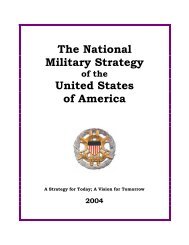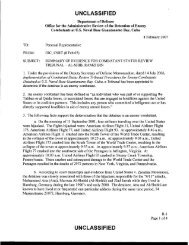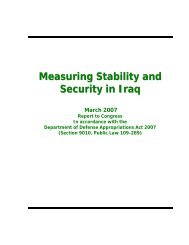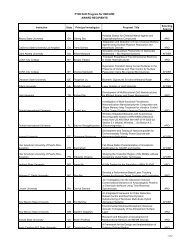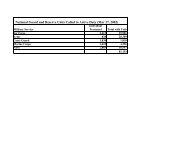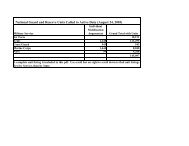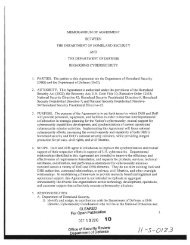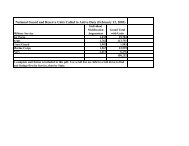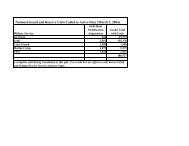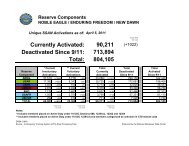Report - United States Department of Defense
Report - United States Department of Defense
Report - United States Department of Defense
You also want an ePaper? Increase the reach of your titles
YUMPU automatically turns print PDFs into web optimized ePapers that Google loves.
UNCLASSIFIED<br />
Within its mandate to support sub-national administrations, and in keeping with direction under<br />
the Presidential Decree 45, the IDLG announced in January 2013 the merit-based appointment <strong>of</strong><br />
70 district and deputy district governors. The overall impact <strong>of</strong> these new appointees has yet to<br />
be seen, but this is a positive move towards enhancing capacity at the district level, both in terms<br />
<strong>of</strong> quantity and quality. The IDLG showed further signs <strong>of</strong> progress recently, including their<br />
establishment <strong>of</strong> a Monitoring and Evaluation Directorate to conduct performance assessments<br />
<strong>of</strong> provincial and district governors, the release <strong>of</strong> a training guide to assist provinces with<br />
production <strong>of</strong> Provincial Strategic Plans, and the release <strong>of</strong> their first annual report assessing<br />
progress on sub-national governance.<br />
A final point <strong>of</strong> contention is the dispute between President Karzai and the Wolesi Jirga over the<br />
status <strong>of</strong> the Independent Directorate for Local Governance (IDLG), fuelled by the latter’s desire<br />
to transform the IDLG into a Provincial Affairs Ministry that would be accountable and<br />
answerable to the legislature.<br />
Taliban shadow governance is <strong>of</strong>ten seen through a military lens; however, shadow governance<br />
contributes to governmental functions at the local level. All provinces in Afghanistan, with the<br />
exception <strong>of</strong> Panjshir, have a recognized Taliban shadow governor. While many districts have<br />
established shadow governors as well, the level <strong>of</strong> influence and control fluctuates significantly.<br />
Most <strong>of</strong> the shadow governor's responsibilities entail continuing the kinetic fight against the local<br />
ANSF or ISAF elements, but where appropriate they are also responsible for administering<br />
limited governmental functions. These <strong>of</strong>ten do not extend beyond taxation and judicial<br />
services. Southern Afghanistan has the most robust shadow governance systems in which<br />
different commissions have been established to separate the civil and military duties. Although<br />
the extent <strong>of</strong> the shadow governance system varies by province and district, the Taliban are able<br />
to establish some influence over the population through the limited shadow governance functions<br />
they carry out. In some areas, local populations see Taliban governance as less corrupt and<br />
abusive than GIRoA.<br />
Sub-National Governance: Capacity-Building Programs<br />
The Independent Directorate for Local Governance (IDLG) has the lead for provincial<br />
nominations and coordinates district-level nominations with the Independent Administrative<br />
Reform and Civil Service Commission (IARCSC). In parallel, the Ministry <strong>of</strong> Rural<br />
Rehabilitation and Development (MRRD) has built up a widespread presence at the village and<br />
district level, responding to a different headquarters in Kabul.<br />
The IDLG continues to support development <strong>of</strong> sub-national government structures in<br />
compliance with National Priority Program for Sub-National Governance (NPP4), and through<br />
policy and planning, capacity development, contract management, and coordination and<br />
facilitation. The directorate faces a number <strong>of</strong> challenges as it takes this work forward, including<br />
the lack <strong>of</strong> adequate security in some areas and remote districts, a reduction <strong>of</strong> donor assistance,<br />
limited and ineffective coordination between donors, implementing partners and ministries, and<br />
the lack <strong>of</strong> approval <strong>of</strong> some <strong>of</strong> the laws and regulations on local governance.<br />
129



